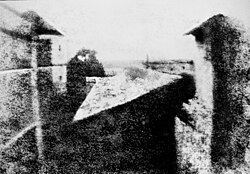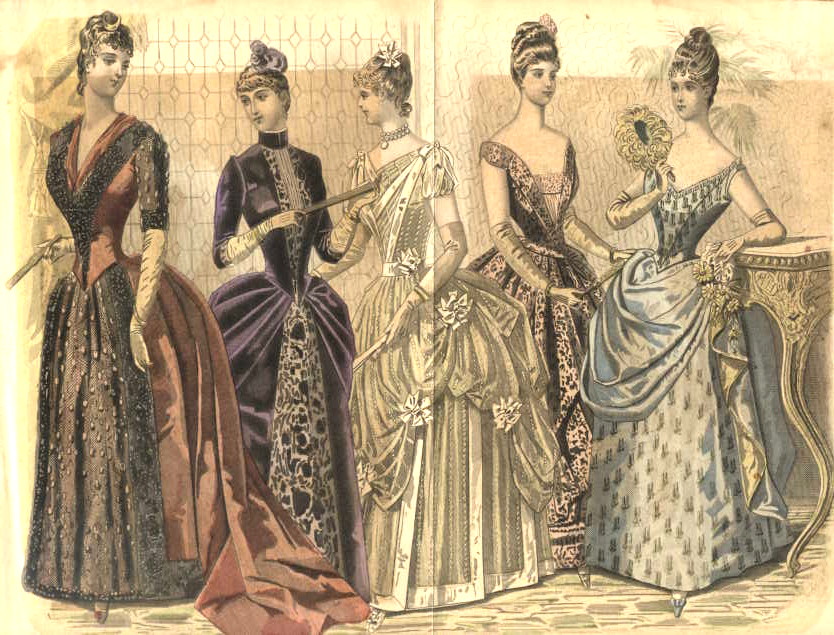
Nicéphore Niépce's earliest surviving photograph of a scene from nature, circa 1826, "View from the Window at Le Gras," Saint-Loup-de-Varennes (France).

"Boulevard du Temple", taken by Louis Daguerre in late 1838 or early 1839,.. was the first-ever photograph of people. It is an image of a busy street, but because exposure time was over ten minutes, the city traffic was moving too much to appear. The exceptions are the two people in the bottom left corner, one who stood still getting his boots polished by the other long enough to show up in the picture.
http://en.wikipedia.org/wiki/History_of_photography
WILLIAM HENRY FOX TALBOT (1800-1877)
Thomas Wedgwood had already made photograms - silhouettes of leaves and other objects - but these faded quickly. In 1827, Joseph Nicéphore de Niepce had produced pictures on bitumen, and in January 1839, Louis Daguerre displayed his 'Daguerreotypes' - pictures on silver plates - to the French Academy of Sciences. Three weeks later, Fox Talbot reported his 'art of photogenic drawing' to the Royal Society. His process based the prints on paper that had been made light sensitive, rather than bitumen or copper-paper.
Fox Talbot went on to develop the three primary elements of photography: developing, fixing, and printing. Although simply exposing photographic paper to the light produced an image, it required extremely long exposure times. By accident, he discovered that there was an image after a very short exposure. Although he could not see it, he found he could chemically develop it into a useful negative. The image on this negative was then fixed with a chemical solution. This removed the light-sensitive silver and enabled the picture to be viewed in bright light. With the negative image, Fox Talbot realised he could repeat the process of printing from the negative. Consequently, his process could make any number of positive prints, unlike the Daguerreotypes. He called this the 'calotype' and patented the process in 1841. The following year was rewarded with a medal from the Royal Society for his work.
http://www.bbc.co.uk/history/historic_figures/fox_talbot_william_henry.shtml
Vogue vs Harpers Bazaar
• Leaders in fashion photography in the 1920’s and 30’s
• Hoyningen-Huene for HB (photographs for Madame Vionnet)
• Horst P. Horst for Vogue
• Cecil Beaton for British Vogue
• Leaders in fashion photography in the 1920’s and 30’s
• Hoyningen-Huene for HB (photographs for Madame Vionnet)
• Horst P. Horst for Vogue
• Cecil Beaton for British Vogue
THE AVEDON YEARS: 1945-1965
Avedon's women leaped off curbs, roller-skated on the Place de la Concorde, and kicked up their heels in nightclubs...
From the time Richard Avedon began creating fashion portfolios for Harper's Bazaar at the age of 22, his photographs intoxicated our readers with his signature cocktail of chic insouciance and boundless vitality.
Born in New York City to a retailing family, Avedon grew up with Bazaar in his home. After serving as a photographer in the U.S. Merchant Marine for two years, he promptly found his mentor in art director Alexey Brodovitch, who, with editor in chief Carmel Snow, hired him as a staff photographer in 1945.
Avedon's women leaped off curbs, roller-skated on the Place de la Concorde, and kicked up their heels in nightclubs, animated by the freedom of the postwar era, the frivolity of youth, and the fabulousness of fashion.
He was immortalized in the 1957 film Funny Face by the character Dick Avery (played by Fred Astaire), who asked, "What's wrong with bringing out a girl who has character, spirit, and intelligence?" During his 20-year career at Bazaar (he left in 1965), Avedon always did just that.



No comments:
Post a Comment